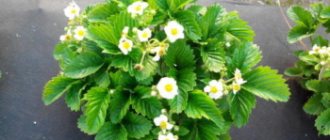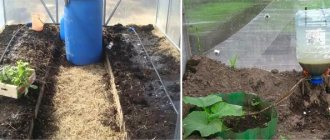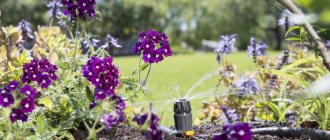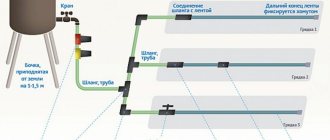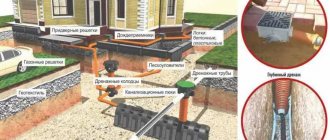Operating principle and advantages of the system
The drip irrigation system supplies moisture directly to the roots of plants, moistening only the soil next to them and not irrigating the rows. At the same time, saturation with water occurs for a long time and evenly, and due to targeted point supply and reduced consumption, significant savings in life-giving moisture occur.
In addition to saving, this approach to watering allows you to get other bonuses:
- reduction of physical costs for maintaining a greenhouse or garden;
- the possibility of leaving the site unattended for several days, and in the presence of an automated system – even longer;
- activating growth and increasing crop yields due to regular watering and the supply of nutrients to the roots, as well as oxygen, which easily penetrates into the soil that is not covered with a caked crust between the rows.
Water is absorbed into the ground point by point, leaving it dry and loose Source poliv123.ru
When deciding how to organize drip irrigation in a greenhouse, many nuances are taken into account, from the type of water source to the type of plants grown and their irrigation requirements. But in any case, such a system will consist of main and distribution pipelines connected to the water source. The latter of which are equipped with water supply elements individually for each plant or small group.
Distribution pipeline system diagram Source mojateplica.ru
How to calculate irrigation time and how much water to supply?
To calculate watering time and amount of water, you need to follow a simple algorithm:
- Consider the area of the greenhouse that must be covered by the drip irrigation system.
- Take into account the type of soil - sandy (recommended water consumption 3 liters per hour), sandy-loam (1.6 liters per hour), loam (1.6 liters per hour), clay (1.6 liters per hour).
- Calculate how long it takes to completely fill the container chosen as the basis of the irrigation system. To do this, you need to turn on the tap and timer, and record the time during which the container is completely filled with water.
Based on the above data, you can accurately calculate how much water in general will be required for irrigation, and how often it should be supplied.
Formula for calculation: Q=60m3/ha*S)/T, where:
- Q – total system capacity;
- S – area to be watered;
- T – watering time per day.
Example of calculation using the formula: Q=60m3/ha*1ha)/T = 3.75m3/h will be required to water the greenhouse for 16 hours.
For convenience, you can use the drip irrigation calculator. To make it easier to perform calculations using a calculator, you can use the following example:
| Index | Number/value |
| Soil type | Sandy |
| Tank filling in seconds | 20 |
| Capacity volume | 10 liters |
Based on the data presented, the calculator offers the following irrigation system parameters:
- It is recommended to consume about 3 l/hour;
- the distance between the lines must be at least 0.3 m;
- total water flow – 55.6/min;
- water consumption per zone – 27.8 min;
- hose length is about 334 m.
Preliminary calculations allow you to save on the purchase of equipment and components, since the owner of the site knows in advance what length the entire path with drip irrigation should have.
Design elements
Today, ready-made drip irrigation systems can be purchased in stores. They are selected according to the total length of the distribution branches, the type of drip lines, the distance between them and other parameters, which will be discussed in detail below. But many gardeners are interested in how to arrange drip irrigation in a greenhouse with their own hands, and whether it is possible to use improvised materials available on the farm.
Could be so. But in order to make a decision, it is better to first study the design in detail.
Sources of water and equipment for its supply
Water can be supplied to a drip irrigation system from a centralized water supply system, a natural reservoir, a well or a borehole. But the most common option is a large container installed on an elevated surface. The water in it is first settled and warmed, and then fed into the pipes by gravity.
Serving from a barrel is the most convenient solution Source yandex.ru
In all cases, except for watering directly from a centralized water supply system, it is necessary to install a pump that pumps water into the pipes at a given pressure. Or feeding it into a distribution container. The type and parameters of the pump depend on the type and depth of the source.
Since any water, even purified tap water, contains impurities in the form of fine sand, silt, particles of rust and undissolved salts, before watering the greenhouse, you need to take care of installing a filter. Without it, the system will quickly become clogged with debris and require cleaning. The main elements – the droppers – are especially affected.
The mesh filter is the most popular, inexpensive and easy to use Source yandex.ru
Pipelines
To distribute water throughout the entire bed or greenhouse, you need a main supply line and branches extending from it along each row of plants. The main pipeline is connected to a water source and equipped with a shut-off device. Most often this is a ball valve, but in an automated system connected to a pressure line or well pump, a solenoid valve is used.
The main line is made of plastic or metal pipes; watering hoses are less commonly used:
- Metal pipes are strong and durable, but their use in a drip irrigation system is not recommended due to their lack of resistance to corrosion. Rust microparticles quickly clog the drip holes.
- Watering hoses are subject to mechanical damage and are not durable.
- It is best to choose the option of making irrigation in a greenhouse with your own hands from PVC or HDPE pipes. These materials are distinguished by their reasonable price and sufficient mechanical strength, they do not corrode, and deposits do not form on their smooth internal walls.
Main line made of polypropylene pipe Source decorateme.com
See also: Catalog of country house projects
In ready-made systems, the role of distribution pipelines is played by drip tubes or drip tapes - flat thin-walled hoses with built-in drips. They come in two main types: emitter and slot:
- The emitter tape has a labyrinth inside with flat droppers located at a certain distance from each other. It can be compensated, which always ensures a constant flow of water from each drip, and uncompensated - its water flow through the drippers differs depending on the distance from the main line and the slope of the area. This type of tape is not cheap, but it does not clog easily and can be used for several seasons.
- The internal labyrinth of the slotted tape is equipped with droppers in the form of long slotted holes. They get clogged easily, so before you water the greenhouse with your own hands using this type of tape, you need to take care of a high-quality filter. But it costs much less than the emitter one, which, however, is offset by the short service life of 1 season in the open ground or a maximum of 2 seasons in a greenhouse.
Fragment of an emitter tape Source isanshop.ru
Drip tapes also differ from each other in such parameters as the total length, the distance between the droppers and their consumption characteristics, and wall thickness.
Note! Most belts are rated at around 1 bar. Therefore, they are used in gravity systems or a pressure reducer is used when connecting to a pressure water supply.
Drip tubes made of low-density polyethylene have thicker walls, so they can withstand high pressure and can work in pressure systems. They are also convenient because they are often produced without holes - they are made independently at the optimal distance for each crop. And external droppers are inserted into the holes or connected to the pipe using thin short hoses.
Drip tube with outlet for 4 droppers Source ekotec.com.ua
In ready-made kits you can find everything to assemble the system, including tubes of different diameters, droppers, adapters, bends for different numbers of outlets, and even pegs for fixing the tubes at the desired level. But all these elements can be purchased separately or replaced. For example, a very relevant question is how to make drip irrigation with your own hands in a greenhouse from a PVC pipe, since it is cheaper than its polyethylene counterparts, as are fittings for assembly.
Special droppers can be replaced with medical ones. They are good because each has a flow-regulating device in the form of a wheel that pinches the supply tube. But the tubes of medical droppers are transparent, which leads to rapid blooming of the water in them and, as a result, their clogging and the need for rinsing.
Homemade system of PVC pipes and medical droppers Source ro.aviarydecor.com
If you choose between drip tapes and tubes, then each type has its own advantages and disadvantages. The pipe system is more durable, it allows you to regulate the water flow and supply it individually to each plant. What is important when growing cucumbers, tomatoes, peppers and other “piece” crops. But it is more expensive than tape and more difficult to assemble.
Tapes are convenient to use when growing root crops, herbs, and strawberries. They are relatively inexpensive, easy to install and clean.
Automation
If the owners do not have the opportunity to constantly be on the site and monitor the condition of the plants, you can think about how to make automatic watering in the greenhouse with your own hands. This can be easily done by equipping the system with a timer. Depending on the functionality, such devices can not only turn on and off the water supply at a given time, but also individually control several lines, monitor the pressure in the network and the operation of pumping equipment, and serve as a water consumption meter.
Types of automatic watering: features
There is no doubt that drip irrigation is useful.
But it can be organized in various ways and it is important to know the nuances of each technique. Special systems produced in factories and factories are quite expensive, and it can be difficult to establish their operation in a specific area
But there are much simpler solutions: drip irrigation can be easily organized with your own hands using droppers. With this method, you can obtain water from wells, wells and even reservoirs of suitable capacity. But connection to open reservoirs in this case is categorically unacceptable.
Droppers are divided into two types: in some, the fluid consumption is regulated, while in others it is set initially. Compensating devices are considered more effective than those without compensation. The "tape" version is considered relatively simple, using a watering tape containing many holes. As soon as water gets into the hose, it begins to flow to the plants.
There are serious disadvantages here:
- it is impossible to change the intensity of water supply (it is strictly determined by pressure);
- It will not be possible to selectively water a separate area;
- some insects can damage relatively thin walls;
- Even a tape that has not been attacked by a mole cricket will last a maximum of three years.
There are other ways to automate drip irrigation. Sprinklers are often used for this purpose, with a spray radius of 8-20 m, depending on the model and operating conditions and operating mode. A polypropylene pipe is used to supply water, but occasionally it is replaced with a layflat hose. A good alternative is drum-type sprinklers, widely used in small and medium-sized agricultural enterprises. Water is immediately sprayed over tens of square meters. The only problem is that it must be taken exclusively from a reservoir and that for a single dacha farm such a solution is unnecessarily expensive.
There is also micro-sprinkling - this method is used both in large plots and in small gardens. All you need is a flexible, perforated hose connected to a stable water source. There are no special differences from drip tape
By paying attention to the features of each option and carefully calculating the necessary parameters, you can obtain a favorable relationship between water consumption and the resulting harvest. This doesn’t always work out the first time, but the experience of thousands of owners shows that everyone can do high-quality drip irrigation
Video description
Useful video on the topic:
See also: Catalog of companies that specialize in the installation of metal structures - canopies, greenhouses and others
Timers can operate from mains or batteries, be mechanical, electro-mechanical or electronic:
- The mechanical timer is manually controlled and has only one function. Before you start watering, you need to turn it on and set the time after which it will stop supplying water. This device is convenient if the area is small and is under constant supervision. It eliminates the need to turn off the water on time and generally keep this concern in mind.
- The electronic-mechanical device can already do more: it provides the specified frequency and duration of watering, independently controlling the system in accordance with the program.
Electronic-mechanical timer with output to two lines Source growsvet.ru
- Electronic controllers are capable of executing up to 16 commands when connecting to them additional devices that monitor soil and air humidity, temperature and other environmental parameters. They can be programmed to different modes for each crop. They are expensive, but they allow you to not have to worry about watering at all, no matter what the weather is like outside and no matter how long the owners’ absence.
When deciding how to make automatic watering in a greenhouse with your own hands, you need to decide in advance on the optimal irrigation mode and choose the most suitable timer in terms of price and functionality. It is installed at the beginning of the system on the main line and does not particularly complicate the process of its assembly.
Electronic timer connected to the central water supply Source treetrekkers.com
Purchased flasks
You've probably seen colored plastic flasks in gardening stores, painted to look like funny faces with a long narrow nose. So, they are used just for automatic watering. Additionally, the devices serve as original decoration. Fill each flask with clean, settled water and insert it into the pot with the plant, spout down.
According to the laws of physics, water will not flow into damp soil. Moisture will begin to flow out of the flask little by little when the soil dries. Due to the small volume of cones, this method will not help during your long absence. However, flowers will be able to survive separation from you for several days even in the heat.
Self-assembly
Having figured out how drip irrigation works in a greenhouse, you can move on to choosing a ready-made kit or assemble the system yourself from individual components.
Drawing up a diagram and calculations
Regardless of the decision made, you first need to draw a diagram, indicating the location of the beds, their length, location of the water source and other details.
On this diagram, the main and distribution pipes are drawn in order to calculate the length of each and determine the number of connecting elements - couplings, angles, tees, plugs, etc.
Approximate diagram Source idei-dachi.ru
When choosing from ready-made kits, it is necessary to take into account the pressure for which the system is designed, the number of droppers in the set, as well as the distance between them. As for their assembly, detailed instructions are included with each kit.
The essence of technology
When watering this type, water is gradually supplied through special devices - droppers - to the base of the plants (for surface installation) or directly to the roots (placement of the system in the ground).
Compared to the sprinkler method, the drip method has the following advantages:
- The humidity in the greenhouse does not increase. This is the main advantage of this method of water supply. With sprinkler irrigation, even in a well-ventilated greenhouse, the humidity jumps, causing many plants to suffer;
- water is used rationally;
- it is possible to apply liquid fertilizers during watering (an easily digestible and safe form);
- there is no need to create high pressure in the system: water can flow by gravity.
With drip irrigation, the weeds remain without moisture.
Video description
You can watch the video for installation master classes:
Note! The pitch between the holes in the drip tape or between the droppers on the tube is selected in accordance with the location of the irrigated plants. If these are onions, carrots, greens and other crops that grow quite closely, it should be about 20 cm. For tomatoes, eggplants and cucumbers, the distance increases to 30-35 cm, so that each bush has its own dropper.
Also, before auto-watering in a greenhouse or garden beds, you need to decide on the volume of the watering tank, which will depend on the number of plants being irrigated and their need for water. This is especially true in cases where automatic replenishment of the container is not provided in the absence of the owners.
Capillary mats
This new product is a great help for gardeners who do not have the opportunity to regularly water their home plants. The capillary mat is a mat made of hygroscopic material. For watering, you will need two large trays of such size that one fits into the other. You need to pour water into the bottom tray. Place a second tray on top with holes made in the bottom, on which place one or more capillary mats (depending on the area of the tray).
Place pots with flowers on the resulting structure, which can absorb moisture coming from below through the drainage holes. You can do it differently by placing bowls with flowers on a mat, the edge of which is immersed in a container of water. In this case, the pots must be removed from individual pallets.
The choice of ways to water flowers in your absence is huge. Everyone can choose the least burdensome option for themselves. If neither method completely suits you, it is better to plant the plants in advance in special flowerpots with a built-in automatic watering system, which are containers with a double bottom. On average, the moisture reserve in such pots is enough for plants for a month.
Plastic bottles for drip irrigation
There is another budget-friendly way to do drip irrigation in a greenhouse yourself. It is based on the use of empty plastic bottles of different sizes: the larger it is, the less often you will have to fill them with water. For example, to water tomatoes or cucumbers growing in normal soil, a 1.5-liter bottle is enough for 2-3 days, and a 6-liter bottle will free you for 7-10 days.
Of course, this method is not suitable for large areas, but for greenhouses or small beds it is quite suitable.
You can organize watering using plastic containers in different ways.
The underground method involves digging a bottle next to the plant to such a depth that water flows from pre-made holes to the roots. The number and diameter of holes are selected in accordance with the type of soil, since water seeps into sandy soil quickly without lingering at the roots, and in clay soil it stays at the surface for a long time.
The penetration of water into the soil depends on its type Source mainavi.ru
The bottle can be placed down or upside down. In the latter case, the bottom is cut off, but not all the way, to form a kind of lid that protects the cavity from debris. If the neck is facing upward, then a hole is pierced in it to allow air to enter and prevent the container from flattening as it is emptied.
To prevent the holes from becoming clogged and silted, a kind of coarse filter made of thin mesh fabric or old nylon tights is put on the plastic container.
Another option for underground drip irrigation is carried out using nozzles in the form of a narrow long funnel, which are screwed onto the bottle instead of a cap. But they are produced only in containers up to 2.5 liters.
Such attachments can be purchased at specialized garden stores Source otomate.ru
The surface method of drip irrigation is also very common. One and a half bottles with a cut off bottom and a hole made in the lid are hung over the garden bed so that the drops fall under the roots of the plants. The basis of such a suspension system can be two supports dug into the ground, between which a strong wire is stretched.
This homemade design can be improved by inserting an empty ballpoint pen with the head removed or the same medical dropper into the hole. It is advisable to seal the connection with silicone sealant, putty or, at worst, plasticine.
Particularly convenient in this type of watering is a dropper, which can be directed exactly to the right place and the intensity of the water supply can be adjusted. And hang the bottles higher so that they do not interfere with the plants and warm up better in the sun. If you do this without using droppers, drops of water may fall on the leaves, causing burns on them.
Video description
Video about the device of drip irrigation from bottles:
Any of these methods allows you not only to water the plants, but also to feed them - just add liquid or dissolved fertilizer, herbal infusion, mullein infusion, etc. to the water.
Unfortunately, such a system cannot be called perfect, because you still have to fill the containers often and with your own hands. In addition, in extreme heat and when the owners are absent from the dacha for several days, the bottles will not cope with the task of proper watering. And their appearance will not decorate the site in any way.

